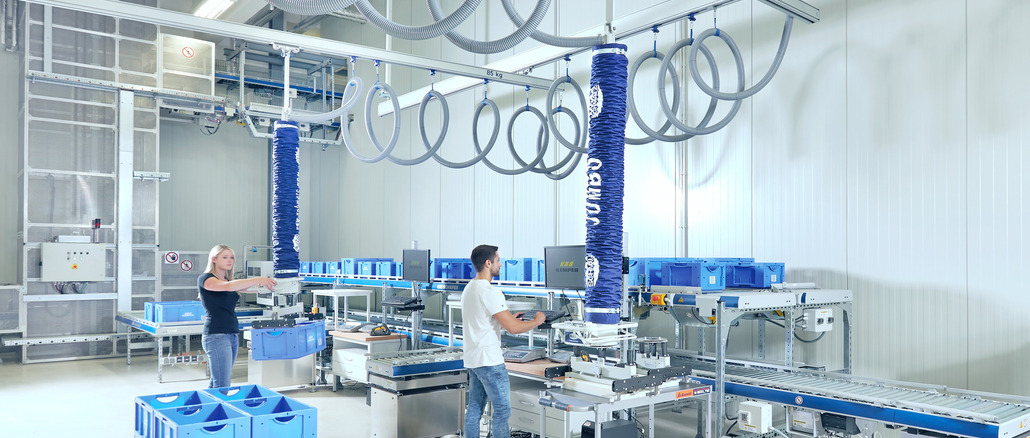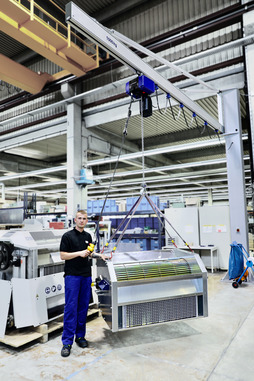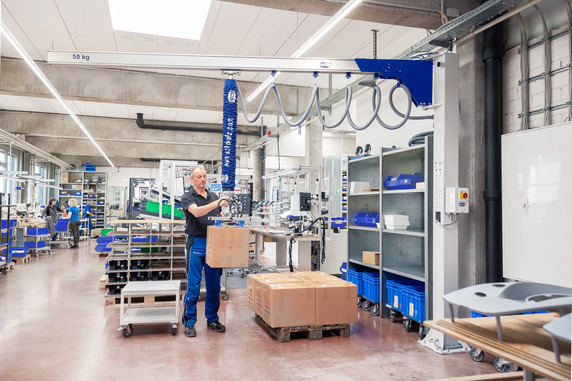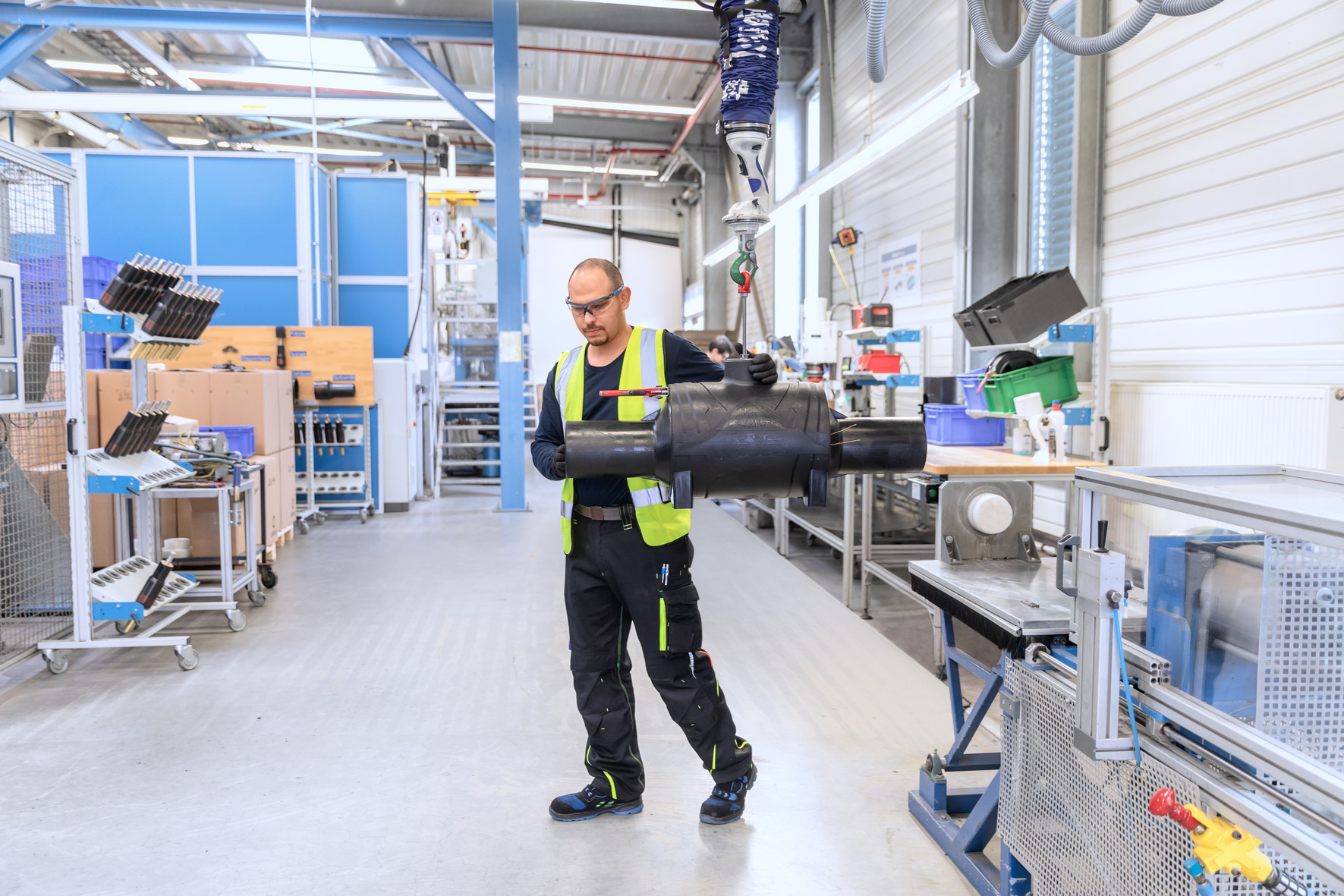
Where cases, cartons or sheets have to be ergonomically moved, stacked or deposited, lifting aids such as the vacuum tube lifter Jumbo are often in use. Any vacuum lifter would be half as useful without one important system: the crane system. Schmalz proves that the right crane solution plays more than a supporting role.

© Schmalz
Lifting aids are the focus when it comes to ergonomics in logistics and material flow. They make it easier to stack thousands of packages a day and make it possible, for example, to place wooden boards weighing up to 300 kilograms on the work table of the CNC machine without getting backache. They can be found in the automotive industry as well as in drugstore warehouses. J. Schmalz GmbH advises its customers when a JumboFlex is preferable to the JumboErgo and whether the VacuMaster must be ordered with or without a swivel device. But that is only the end of the system.
Before that, the vacuum experts look up. You know which crane ideally complements the ergonomic lifting aid. The range is as diverse as the application scenarios: Suspension and gantry cranes enable large working areas and carry up to 1,200 kilograms. Slewing cranes can be attached to existing hall columns or the wall to save space. In the absence of these, they are doweled to the ground with the crane column and base plate and ensure ergonomic handling for loads of up to 1,000 kilograms. Special solutions enable the bypassing of interfering contours or the use of vacuum tube lifters in lower spaces.
The common denominator: they all have a modular design and can be integrated flexibly. In addition – and here it becomes clear that they offer much more than just additional reach – they are made of aluminum and thus particularly smooth-running. The amount of force required to start up and move the machine is reduced by 60 percent compared to a steel alternative. In short: they provide additional ergonomics in everyday handling.
“We achieve this through the very favorable ratio of dead weight to payload and with the help of special low-friction rollers,” explains Michael Schlaich. He has been responsible for business development handling since October 2018. The switch from steel to aluminum came about 15 years ago: Instead of buying in steel cranes, Schmalz developed a modular system for crane systems based on aluminum profiles. This is specially designed for optional combination with vacuum tube lifters of the Jumbo family, vacuum lifting devices of the VacuMaster series and chain hoists.
Based on five different extruded aluminum profiles with hollow chambers, the consultants work with the user to configure a crane system that is optimized in terms of weight, load capacity and cost. Numerous additional components are available for the design of individual crane solutions, such as jacks for adapting the crane system to low room heights or service stations for the simple replacement of transport trailers.
Measurement is just as much a part of the service as practical tests on sample cranes at Schmalz on site. “Our modular system has many advantages. One is that we can implement the right solution for any task in a short time,” Schlaich tells us. In addition, thanks to the modular design, Schmalz is quickly on site with spare parts and can replace individual components or expand the system. Whether new or extended – safety is always guaranteed, as Michael Schlaich affirms: “All our systems are tested by independent strength calculations of all load-bearing components and are therefore safe!”
270 degrees ergonomics
“The most frequently requested is the column-mounted slewing crane. It is universal, does not necessarily need a wall or ceiling. The variant with crane column and mobile base plate can be flexibly implemented with the help of a forklift truck if the customer changes the hall layout,” explains the Head of Business Development. “In most cases, the maximum load capacity of a crane is not decisive. In combination with the vacuum tube lifter, what counts more are the dynamics, ease of movement, and thus the user-friendliness and the gain for the user’s health,” the manager emphasizes. The boom can be up to six meters long and can be swiveled 270 degrees if desired.

© Schmalz
In addition to the standard version, there are several special versions: With the aluminum flat boom, Schmalz launched a variant in 2018 that allows the use of vacuum tube lifters even in lower spaces. “Before that, we used a steel structure. This was harder to move and did not build as flat. Now we not only gain almost ten centimeters, but also solve handling tasks with maximum ergonomics in lower spaces,” adds Schlaich.
Additional space is saved by the new Schmalz V-Chain energy supply system: It packs the hose package of the vacuum supply into a drag chain – no hanging loops mean that forklifts can also pass safely under the boom. If hall columns or machines are in the way or if working areas are difficult to reach, the articulated or telescopic boom is used. “Both special cranes are now also available as a modular system. This enables individual crane configurations and thus even more flexible handling solutions,” reports Michael Schlaich.
Under the ceiling
If higher loads have to be carried or a larger working area has to be covered, Schmalz designs portal or suspension cranes. “The plants that span a few square meters are particularly impressive,” Schlaich says. Often, several vacuum lifters are suspended in one system – so one rail system covers several workstations, for example, in shipping, assembly lines or baggage handling at the airport.
An electric travel drive for suspension crane systems optionally supports the user in moving and positioning loads weighing up to 800 kilograms. Soft start and stop make starting and stopping quiet and reduce vibrations. “The drive is an ideal extension for our chain hoist, which lifts heavy loads solo or in combination with the VacuMaster vacuum lifting device,” adds Schlaich. It does not always have to be the complete system consisting of a crane and vacuum handling system. Schmalz also configures crane systems that users can combine with customer-specific lifting solutions such as belts.
Will the crane remain analog?
Schmalz is known for its smart vacuum systems. In the crane sector, things are more down-to-earth. But where it makes sense, there are points of contact, as shown, for example, by the swing angle limitation with process monitoring. A two-channel switch with roller lever is mounted on the side of the crane boom. The control system of the surrounding plant communicates with it in order to release or block travel paths or processing steps and machines. “Of course, the crane is also taking part in digitization. But so far it has been more of an extra. The paradigm shift is taking place through the various vacuum handling systems,” Schlaich explains.
Web:
www.schmalz.com



